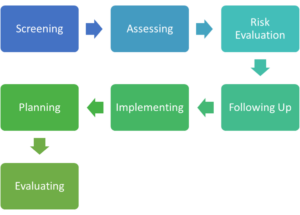Organizations rely on the case management process to simplify and make complex problems more manageable. This process provides organizations with scalable, repeatable, and efficient workflows to facilitate the successful resolution of these complex issues. Case management software provides organizations with a streamlined solution to track and resolve cases.
What is case management?
A “case” in case management refers to a single occurrence of an event, problem, or incident. It can be many different things depending on what product or service an organization provides. Examples of possible cases may include:
- customer complaints
- support tickets
- customer onboarding
- fraudulent transactions
The case management process involves taking a complex problem and simplifying it through the implementation of replicable workflows. Organizations typically rely on case management software to create, implement, and evaluate these workflows.
Case management workflows specify how a case will proceed from start to finish. Without established case management processes, organizations will struggle with resolving and tracking cases, achieving consistency in outcomes, making costly errors, and experience higher operating costs.
Case Management System Features
The features of a case management system will vary across industries and depending on the products and services that an organization provides. However the system process will include:
- Gathering and managing information
- Decision making
- A shared interface
- Retaining information for compliance purposes
Gathering and managing information
The case management process should help an organization to gather information, extract important information, and organize it in a centralized database. The ability to easily access this information is key to accessing risk, designing and implementing a plan, and evaluating the process to identify potential improvements.
Decision making
A case management system helps organizations to make simple and consistent decisions based on established criteria. Decision making can be fully automated or can aid humans in making more informed decisions.
A shared interface
Information should be accessible by key stakeholders through a user-friendly dashboard. This facilitates the easy access and sharing of information, not just within the organization, but also with customers and relevant third parties.
Retaining information for compliance purposes
It is important to track case history and retain copies of notes, communications, and important documentation. Your case management should help to create an audit trail to increase compliance and provide enhanced follow-up opportunities.
Benefits of the case management process
The case management process offers a wide range of benefits at the organizational level. One of the most important benefits is the ability to make complex problems manageable by implementing efficient workflows. With established workflows in place, case managers and other stakeholders can come up with and implement effective plans on a consistent basis.
Other benefits of the case management process include:
Quicker resolution of cases
Case management software streamlines the handling of an organization’s cases. Team members can use one solution to communicate, and track and improve cases. A streamlined process increases both efficiency and employee productivity.
Enhanced record-keeping
With case management solutions, organizations can retain all case relevant information in one easy to access database. Advanced document management features make it easy to collect, extract, categorize, and store important data.
Efficient collaboration
Case management software streamlines communication, allowing stakeholders to access information and communicate through a single interface. This helps case managers and other representatives to provide customers with updates in real-time.
Easy access to information
The ability to quickly access information regarding a specific case greatly expedites their resolution.
Elimination of manual processes
Automated case management solutions remove the need to collect paperwork, allowing documentation to be gathered and stored electronically. Manually collecting documents from customers and other parties wastes valuable resources and delays the successful resolution of cases. This keeps the organization from providing excellent customer care.
Providing superior customer service
A superior level of care is provided by facilitating customer communication and enabling the timely resolution of their concerns.
Understanding customers better
Case management systems can help organizations to analyze data to spot trends, focus on key performance indicators, and identify opportunities to better serve customers. Analyzing data is key to the evaluation phase of the case management process. Without access to data, it is difficult, if not impossible, for organizations to improve their processes.
Potential uses of case management
Potential use cases for case management depend largely on the industry and the products and services that an organization provides. The case management process can be utilized in both business use and system use cases. In both areas case management helps an organization to optimize its processes.
There are several examples of case management use cases that are common across industries. Whether an organization provides products or services, they generally require a centralized process for addressing customer support issues. These include important functions like assigning tickets, processing service requests, tracking cases, and corresponding with customers. Case management software helps organizations to handle all these issues through one easy to use solution.
Another common use case is customer onboarding. Customer onboarding has traditionally been time consuming and inefficient for organizations. Onboarding is simplified through automation and structured process routes. Case management software is particularly effective at automating those processes that have traditionally been the most inefficient and wasteful.
The phases of the case management process

The case management process consists of seven phases. These phases are not linear and are meant to provide a wholistic approach to the process from start to finish. The approach provides flexibility, allowing a case manager to return to earlier phases as needed. For example, during the follow-up stage, a case manager may learn that the implemented plan did not resolve the issue. Here, the case manager would need to return to the planning phase to come up with another solution.
The seven phases of the case management process are:
- Screening
- Assessing
- Determining risk
- Planning
- Implementing
- Following-up
- Evaluating
Screening
This initial phase of the case management process is designed to eliminate those cases that do not require resolution or that can be resolved quickly. The case management process is used to solve complex problems at scale. By eliminating those issues that do not warrant further action, an organization saves precious resources while boosting efficiency.
Screening cases does not mean that complaints are disregarded or that an organization has poor customer service practices. Rather, in this phase, an organization should timely respond to each individual’s request for assistance, inform them about the process and decisions made, and advise them of alternative options, if available.
Assessing
Like the screening process, in the assessing phase, a case manager reviews the information provided. However, the purpose when assessing is to thoroughly understand the issue to craft a solution, not determining whether the problem is eligible for the case management process.
The case manager will gather additional information, typically by conducting an interview with the appropriate party, like a customer or employee. In addition to gathering information to access the problem, this is an opportunity for the case manager to reassure. When interacting with customers making them feel appreciated is an important part of the case management process.
Organizations should craft questionnaires to aid case managers in collecting information. These should only be used as guides. It is more important to establish a dialogue versus administering a question and answer session. Creating and storing questionnaires is simple with case management software.
Determining risk
This phase of the case management process serves a triage function. Case managers are tasked with determining the case’s risks and prioritizing its resolution in relation to other cases. This is often accomplished by assigning some measure of prespecified risk.
Determining risk plays an important role in the overall efficiency of the case management process. By prioritizing, organizations can allocate their resources towards resolving the most pressing issues. For instance, suppose the fraud department at a bank receive a ticket from a customer disputing a small charge on his or her credit card. The bank also receives a ticket that some unauthorized wire transfer emptied out another customer’s savings account.
Both issues are pressing, particularly from the viewpoint of each customer, but one is clearly more urgent than the other. In this instance, it makes sense to prioritize the second ticket over the first. Once a case manager has a grasp of the risks of each case, he or she can begin planning a solution.
Planning
In the planning phase, the case manager clarifies goals and objectives, and identifies actions necessary to achieve them. Goals must be achievable and specific. Broad goals should be broken down into smaller steps.
The case manager must choose the appropriate resources for achieving the objectives. This is where having established workflows play an invaluable role. Readily accessible and easy to follow workflows aid case managers in choosing the correct course of action. They also ensure consistency across cases and the organization as a whole.
It is worth noting that the planning phase will not always be possible or practical. For instance, where the resolution of a case is urgent and there simply is not enough time to plan. Where case managers experience difficulties identifying and setting objectives, it is often necessary to return to prior phases in the case manager process to gather additional information.
Implementing
In the implementation phase of the case management process, the case manager executes the plan he or she created in the planning phase. For instance, suppose a customer files a support ticket for a technical issue with some piece of hardware like a laptop or television. Implementation may involve contacting and scheduling an appointment with a technician in the field, or arranging return shipping of the item.
The implementation phase of the case management process provides an invaluable opportunity to collect data. Case managers should take note of what they did. This information can be used to improve the handling of future cases, as well as improve the efficiency of the case management system.
Following-up
In the follow-up phase, the case manager reaches out to the appropriate parties to collect information and determine if the solution was effective. Returning to our example from above, if the case manager scheduled a technician to visit the customer, he or she would determine if the technician visited and successfully repaired the item.
The case manager may find that the plan was implemented smoothly and satisfied all objectives. Or the issue may not be fully resolved and requires further action. If so, the case manager must return to the planning phase to develop a new plan of action. Following implementation of the new plan, the case manager will follow-up again to determine resolution, and so on until the case is resolved.
Evaluating
In this last phase of the case management process, the case manager collects data and feedback. This includes data like the results, costs, and duration of the case. The organization uses this information to create reports and evaluate the case management process from both a ROI and cost perspective. Where necessary, improvements are made in the process to increase efficiency.
We noted above that the implementation phase provides an invaluable opportunity to collect data. The organization should look at what worked and what did not. Detailed records of methods and successful resolutions should be kept to avoid implementing ineffective plans in future cases. Stakeholders should regularly collaborate on alternative solutions that can be implemented in future cases.
 About ProcessMaker
About ProcessMaker
ProcessMaker is a low-code business process management software. Hundreds of commercial customers, including many Fortune 100 companies, rely on ProcessMaker to digitally transform their core business processes enabling faster decision making, improved compliance, and better performance. Schedule a 7 day free trial or download our whitepapers.





